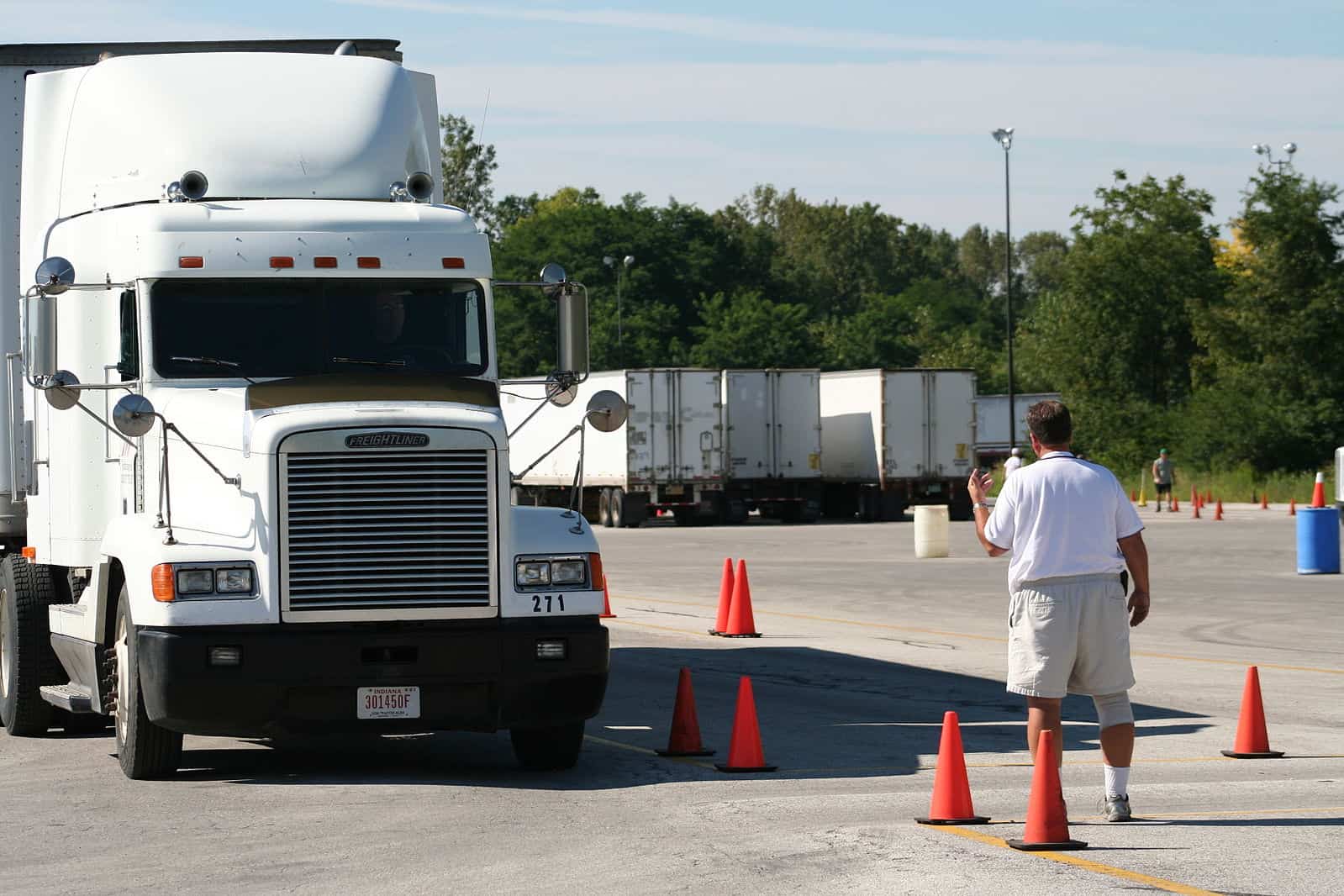
Julia Huang is a student at Harvard Law School and a member of the Labor and Employment Lab.
The House has finally passed the $1.2 trillion bipartisan infrastructure bill. Among many other things, it promises spending on road improvements and broadband access. But in a potentially dangerous move, the infrastructure bill invites young 18- to 20- year old drivers to drive semi-trucks on interstate highways, instead of solving the industry’s turnover and recruitment issues.
According to the American Trucking Association (“ATA”), there is a truck driver shortage of over 80,000 drivers in 2021. 71% of the U.S. economy’s goods are moved by truck drivers, and consumer demand has only increased during the pandemic. In response, and despite a failed attempt in 2019, members of Congress introduced the Developing Responsible Individuals for a Vibrant Economy Act (DRIVE Safe Act) to lower the minimum age for interstate commercial truck drivers from 21 to 18 years old. This time, however, the bill was included as part of the larger bipartisan infrastructure bill.
More specifically, the DRIVE Safe Act creates an apprenticeship program for licensed commercial truck drivers under the age of 21. Apprentices are required to complete 400 hours of on-duty time, 240 of which must be driven in a commercial motor vehicle. Apprentices must also be accompanied by an experienced driver, and the commercial motor vehicles must be furnished with certain safety technology, such as active braking collision mitigation systems and video event capturing systems.
But should we be increasing the number of young truck drivers? According to a 2019 report from the Insurance Institute for Highway Safety, the rate of fatal crashes per miles driven for 16-19-year-old drivers is almost three times the rate for drivers over 20. When looking at truck drivers specifically, 16- to 19-year old commercial drivers in California demonstrated higher accident rates than drivers aged 20 to 24 (67 accidents vs. 19 accidents per 1,000 licensed drivers). In Michigan, 18- to 19-year old truck drivers had over five times as many casualty involvements per 1,000 drivers versus the average overall rate. In general, teenage drivers are also more likely to speed and kill pedestrians and cyclists.
Opponents of the bill state that because mandated training hours are no different from what new truckers (21 and over) already do, the apprenticeship program does not actually have any added protections to account for the younger age. Critics also argue that employers are the ones judging whether the apprentices have met their benchmarks and mandated technology will become a liability for the young drivers once they leave the training vehicle. Now add in the pressure to drive long hours. With these hazards, would the industry really solve its issues with young drivers?
In its efforts lobbying for the bill, the ATA has focused on age. The organization’s chief economist, Bob Costello, said, “The No. 1 reason [for the shortage] is because of the retirement of existing drivers.” With the average age of truckers at 54 years old and 25% of current truckers reaching retirement, the ATA argued that including 18-year-olds will allow trucking to become a first-career option for those who would not otherwise wait until they were 21. As suggested by the 35-year-old average of truck drivers in training schools, current drivers consider the trucking industry primarily as a second-career.
Supporters of the bill have also argued that 49 states and the District of Columbia already allow drivers under the age of 21 to drive large trucks within the state. The Military Commercial Driver Pilot Program also currently allows 18- to 20-year-old veterans with military training to drive between states. However, in a testimony before a U.S. Senate committee in May 2021, Teamsters raised concerns over the evidence of higher crash rates for young drivers, and questioned how the age requirement could be lowered when the government has not yet concluded its research on the 18- to 20-year old drivers with military experience, as required by the Fixing America’s Surface Transportation Act. And despite the ability to drive intrastate, only 0.33% of registered commercial motor vehicle drivers in 2001 were under the age of 21.
Teamsters General President Jim Hoffa argued in 2019, “Younger drivers should not be expected to tolerate substandard working conditions any more than their older counterparts.” He pointed to the “rampant turnover,” the “low pay,” and the “tough working conditions” as problems Congress should address before taking the controversial step of introducing young interstate commercial drivers.
Perhaps the rigors of the job should be improved instead of foisting them on teenagers. Opponents to the bill argue that there is no shortage of truck drivers at all. With 450,000 commercial driver’s licenses issued by states every year, burnout is the problem, not the lack of younger drivers.
Long-haul truckers work 60-70 hour weeks, but get paid by miles traveled, an average of 52.3 cents per mile. Loading times and longer hours due to traffic or weather slowdowns therefore do not get compensated. Nor does off-time spent away from home. A lack of parking spots has also led to drivers stopping earlier just so that they can secure one for the night. This cut into driving time has led to a $5,500 loss in annual compensation. Such a payment system can push a driver to push on despite their driver fatigue, a known crash risk. Truck drivers are federally allowed to drive up to 11 hours within a 14 hour shift. As a result, they endure a largely sedentary workday with constant exposure to exhaust and diesel fumes. Almost 40% of truck drivers do not have sick leave or health insurance. Many of these issues stem from truckers’ misclassification as independent contractors rather than employees. Furthermore, with new low-wage nonunion carriers emerging in the industry, union membership has decreased, and Teamsters only represent 2% of truck drivers. Driver turnover is at 90%.
The glaring lifestyle issues of the trucking industry are likely the reason why women constitute only 7% of all truck drivers. Why target the under-21 drivers before the millions of 21 and over female drivers? Unlike young drivers, female truck drivers get into fewer and less serious accidents. Some states are supporting this initiative to gain more female drivers by funding their certification, and the infrastructure bill includes a provision focused on recruiting more female drivers. The Promoting Women in Trucking Workforce Act was reintroduced in Congress in February 2021. However, the industry’s working conditions are still not appealing for women, lacking benefits like parental leave or flexible hours, and continuing to tolerate sexual misconduct in some cases.
Another source of driver loss for the trucking industry has been the federal Drug & Alcohol Clearinghouse, which provides employers with records of driver drug and alcohol program violations. 70,000 drivers have tested positive for marijuana, a federal crime still, and ATA’s Costello believes that the majority of them will not attempt the return-to-duty process after failing the drug test. Perhaps the trucking industry should better incentivize these drivers to start the process.
Not enough attention has been given to the DRIVE Safe provision and attempts to fulfill supply need with teen drivers. On November 3, 2021, House Republicans introduced the Supplying American Needs Truckers Aged 18 Act (SANTA 18 Act) to allow teen truck drivers to access port pickups before the holiday season. Before enlisting teenage drivers to handle 18-wheelers, more efforts should be made first to improve the burnout lifestyle of truckers and recruitment for female or 21- to 35-year old drivers. The burnout of young drivers should not come first.







Daily News & Commentary
Start your day with our roundup of the latest labor developments. See all
December 22
Worker-friendly legislation enacted in New York; UW Professor wins free speech case; Trucking company ordered to pay $23 million to Teamsters.
December 21
Argentine unions march against labor law reform; WNBA players vote to authorize a strike; and the NLRB prepares to clear its backlog.
December 19
Labor law professors file an amici curiae and the NLRB regains quorum.
December 18
New Jersey adopts disparate impact rules; Teamsters oppose railroad merger; court pauses more shutdown layoffs.
December 17
The TSA suspends a labor union representing 47,000 officers for a second time; the Trump administration seeks to recruit over 1,000 artificial intelligence experts to the federal workforce; and the New York Times reports on the tumultuous changes that U.S. labor relations has seen over the past year.
December 16
Second Circuit affirms dismissal of former collegiate athletes’ antitrust suit; UPS will invest $120 million in truck-unloading robots; Sharon Block argues there are reasons for optimism about labor’s future.